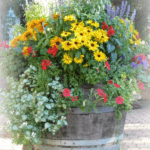Gardens edging ideas play a crucial role in enhancing the overall look of your outdoor space. Edging serves both practical and aesthetic purposes, helping to define garden beds, pathways, and other landscape features while also preventing soil erosion and keeping weeds at bay. Whether you have a traditional cottage garden or a modern minimalist oasis, the right edging can elevate the beauty of your outdoor sanctuary.
When it comes to choosing the perfect edging for your garden, there are various materials to consider. From classic options like brick and stone to more contemporary choices such as metal or plastic, each material brings its own unique charm to the design. The type of material you choose will depend on your garden’s style, maintenance preferences, and budget constraints.
In this article, we will explore a variety of gardens edging ideas that cater to different tastes and preferences. From timeless traditional designs that exude elegance to innovative and creative concepts that push the boundaries of conventional landscaping, there is something for every gardener looking to add that perfect finishing touch to their outdoor haven.
Let’s delve into the world of garden edging and discover how these simple yet impactful elements can transform your green paradise into a breathtaking masterpiece.
Types of Edging Materials for Gardens
When it comes to creating a well-defined and polished look for your garden, choosing the right edging material is crucial. There are various options available, each with its unique characteristics and benefits. One popular choice for garden edging is brick, which provides a classic and timeless look. Brick edging is durable, easy to install, and can complement both traditional and modern garden designs.
Another common material for garden edging is stone. Stone edging gives a natural and rustic feel to the landscape while adding a touch of elegance. It is long-lasting and requires minimal maintenance, making it an excellent choice for homeowners looking for a durable and versatile option. Additionally, stone edging can be easily customized to fit different shapes and sizes, allowing for creative designs in the garden.
For those seeking a more contemporary look, metal or steel garden edging can be a stylish choice. Metal edging offers clean lines and a sleek finish that complements modern garden designs beautifully. It is also highly durable and resistant to weather conditions, ensuring that your garden remains well-defined year-round. Whether you opt for brick, stone, metal, or other materials like wood or concrete, selecting the right edging material can significantly enhance the overall aesthetic of your garden.
| Edging Material | Benefits |
|---|---|
| Brick | Durable, easy to install, complements traditional and modern designs |
| Stone | Natural, rustic feel; long-lasting with minimal maintenance |
| Metal/Steel | Contemporary look; clean lines; highly durable with weather resistance |
Traditional Edging Ideas for Classic Garden Styles
When it comes to classic garden styles, traditional edging plays a crucial role in adding a timeless charm to the outdoor space. One of the most popular traditional edging materials is bricks.
Brick edging creates a neat and structured look, perfect for formal gardens or those aiming for a more traditional aesthetic. The beauty of brick edging lies in its versatility – it can be laid in different patterns such as herringbone or soldier course to suit the overall design of the garden.
Another traditional edging idea that never goes out of style is using natural stone. Whether it’s cobblestones, fieldstones, or flagstones, natural stone edging adds a touch of rustic elegance to classic garden designs.
The irregular shapes and earthy colors of natural stones blend seamlessly with lush greenery and colorful blooms, creating a harmonious and inviting atmosphere. Natural stone edging is durable and long-lasting, making it a worthwhile investment for homeowners looking to enhance the beauty of their outdoor spaces.
For those who prefer a more formal look, consider using metal edging in classic garden styles. Metal edging materials like steel or aluminum offer clean lines and a contemporary edge while still maintaining an air of tradition. Metal edging is particularly suitable for defining pathways or separating different sections in the garden with precision. Whether you opt for sleek black metal or rustic bronze finishes, metal edging provides both functionality and aesthetic appeal to classic garden designs.
| Edging Material | Benefits |
|---|---|
| Bricks | Versatile in patterns; Neat and structured look |
| Natural Stone | Rustic elegance; Blends with greenery; Durable |
| Metal (Steel/Aluminum) | Clean lines; Contemporary edge; Precision defining of pathways |
Modern and Creative Garden Edging Ideas
Incorporating modern and creative garden edging ideas can add a unique and stylish touch to your outdoor space. There are countless innovative ways to define the borders of your garden beds, pathways, and other features, giving your garden a fresh and contemporary look. One popular trend in modern garden edging is using unconventional materials, such as recycled glass bottles, steel pipes, or even reclaimed wood, to create eye-catching borders that stand out from traditional options.
For those looking to add a touch of whimsy to their garden, consider incorporating colorful tiles or mosaic patterns along the edges of flower beds or walkways. This not only adds a pop of color but also creates a visually stunning focal point in the garden. Another modern edging idea is to use geometric shapes or patterns, such as hexagons or chevron designs, for a sleek and minimalist look that complements contemporary landscaping styles.
Additionally, incorporating lighting into your garden edging design can enhance the overall aesthetic of your outdoor space. LED strip lights or solar-powered fixtures can be installed along the edges of pathways or around raised garden beds to create a soft ambient glow at night.
This not only adds an element of safety by illuminating key areas but also accentuates the beauty of your gardens even after the sun sets. By exploring these modern and creative garden edging ideas, you can transform your outdoor oasis into a visually stunning and one-of-a-kind retreat that reflects your personal style.
Choosing the Right Edging for Your Garden’s Aesthetic
When it comes to choosing the right edging for your garden’s aesthetic, there are a plethora of options to consider. The key is to select an edging material that complements the overall style and design of your garden space. Here are some ideas and materials that you can explore:
- Brick Edging: A classic and timeless choice that works well with traditional garden styles. Bricks can be laid in various patterns, such as herringbone or soldier courses, to add a touch of elegance to your garden.
- Wood Edging: Perfect for creating a natural and rustic look in your garden. Wood can be easily cut and shaped to fit the contours of your flower beds or pathways. Opt for treated lumber or cedar for longevity.
- Stone Edging: Ideal for formal gardens or those aiming for a more structured appearance. Stones come in various shapes, sizes, and colors, allowing you to create a custom look that enhances the beauty of your plants.
For a more modern and creative approach to garden edging, consider exploring unconventional materials such as recycled glass bottles, metal strips, or even colorful tiles. These unique choices can add an element of whimsy and personality to your garden while still serving the practical purpose of defining spaces.
Remember to take into account not just the visual appeal but also the functionality of the edging material. Consider factors such as durability, ease of maintenance, and cost when making your final decision. By selecting the right edging for your garden’s aesthetic, you can elevate the overall look and feel of your outdoor space while providing a clear boundary between different areas within your garden.
DIY Garden Edging Projects for the Budget-Friendly Gardener
For budget-friendly gardeners looking to spruce up their outdoor space, DIY garden edging projects can be a great way to add some character and definition without breaking the bank. There are endless creative and cost-effective ways to create beautiful edges for your garden beds, pathways, and other features.
One popular option for DIY garden edging is using recycled materials such as old wine bottles, tin cans, or even reclaimed wood. These items can be repurposed into unique and eye-catching borders that not only serve a practical purpose but also add a touch of whimsy to your garden. Another eco-friendly option is using natural elements like stones, pebbles, or seashells gathered from your own backyard or local beach.
If you’re feeling crafty, you can also try your hand at concrete or cement edging. Using molds or forms, you can pour your own custom edging pieces in various shapes and sizes to fit the specific design of your garden. This is a durable and long-lasting option that adds a modern touch to any outdoor space.
Plus, you can customize the color and texture of the concrete to match your existing décor or landscaping theme. Whichever DIY garden edging project you choose, always remember to consider the overall aesthetic of your garden and how the edging will complement its style.
Edging Tips for Low-Maintenance Gardens
Low-maintenance gardens are becoming increasingly popular for those looking to enjoy the beauty of a garden without the constant upkeep. When it comes to edging, there are a few tips and ideas that can help keep your low-maintenance garden looking neat and well-kept without requiring too much time and effort.
Use Natural Elements for Edging
One great way to create a low-maintenance edge for your garden is by using natural elements such as rocks, stones, or even driftwood. These materials not only add a touch of natural beauty to your garden but also require minimal maintenance. Simply arrange them along the border of your garden beds or pathways to create an organic and easy-to-maintain edge.
Opt for Perennial Plants as Edging
Another tip for low-maintenance garden edging is to use perennial plants as a border. Perennials require less maintenance than annuals as they come back year after year without needing replanting. Choose low-growing perennial plants that won’t require frequent trimming and maintenance, such as lavender, daylilies, or sedum. This not only adds a pop of color to your garden but also creates a natural and effortless edge.
Consider Gravel or Mulch Edging
For a simple yet effective edging solution for low-maintenance gardens, consider using gravel or mulch along the borders of your garden beds. Gravel provides a clean and modern look while also helping with drainage, while mulch adds a natural touch and helps retain moisture in the soil. Both options require minimal upkeep and can easily be topped up when needed to maintain their appearance.
Additionally, they can help suppress weeds along the edges of your garden beds, further reducing maintenance tasks. By incorporating these edging tips into your low-maintenance garden design, you can create a beautiful and well-defined space that requires minimal effort to keep looking its best.
Edging Ideas for Specific Garden Features (Eg Flower Beds, Vegetable Patches, Pathways)
Flower Bed Edging Ideas
When it comes to edging your flower beds, there are countless creative options to enhance the beauty of your garden. One classic and elegant choice is using natural stone or brick edging to create a clean and defined border around your flower beds. This timeless look adds a touch of sophistication to any garden.
For a more whimsical and rustic feel, consider using wooden logs or tree branches as edging materials. These natural elements can blend seamlessly with the surrounding greenery, giving your garden a charming woodland vibe.
Vegetable Patch Edging Ideas
Edging your vegetable patches not only adds visual appeal but also serves a practical purpose by keeping mulch and soil in place. One popular option for vegetable patch edging is using metal or plastic garden trim, which provides a clean and durable border for your crops.
Another eco-friendly alternative is repurposing old wine bottles as colorful edging markers for your vegetable beds. Not only does this add a unique and quirky touch to your garden, but it also helps recycle glass bottles that would otherwise end up in landfills.
Pathway Edging Ideas
Creating defined borders for pathways in your garden can help guide visitors through your outdoor space while adding structure and visual interest. For a traditional look, consider using gravel or pea stone as pathway edging materials, providing a smooth transition between the path and surrounding greenery.
If you prefer a more modern and minimalist aesthetic, sleek metal or concrete pavers can be used as edging to give your pathways a contemporary feel. Whichever option you choose, proper pathway edging will not only enhance the overall design of your garden but also ensure safe and well-maintained walkways for all who wander through it.
Conclusion
In conclusion, adding the perfect edging touch to your garden can truly enhance its overall aesthetic and provide a polished look. Whether you opt for traditional materials like bricks or stones, or get creative with modern options like recycled glass or metal strips, the right edging can make a significant difference in the appearance of your outdoor space.
By carefully selecting the appropriate edging material that complements your garden’s style and theme, you can create a cohesive and visually pleasing landscape.
Moreover, DIY garden edging projects offer budget-friendly options for those who enjoy getting hands-on with their gardening tasks. From repurposing old items like wine bottles or tires to creating intricate designs with simple tools, there are endless possibilities for adding a personal touch to your garden’s borders. Not only do these DIY projects allow for customization and creativity, but they also provide a sense of accomplishment and pride in beautifying your outdoor space.
When considering edging ideas for specific garden features such as flower beds, vegetable patches, or pathways, it is essential to choose edging materials that not only define these areas but also complement the plants and structures within them. Edging serves both a functional and aesthetic purpose in gardens, helping to prevent grass or weeds from encroaching on plant beds while also providing a clean and tidy appearance.
By incorporating the right edging elements tailored to your garden’s unique layout and design, you can achieve a harmonious balance between form and function in your outdoor oasis.
Frequently Asked Questions
What Is the Easiest Garden Edging to Install?
The easiest garden edging to install is typically flexible or plastic edging. These materials are lightweight, easy to cut or shape, and can be simply inserted into the ground along the border of your garden beds.
What Is the Best Type of Garden Edging?
The best type of garden edging really depends on personal preference and the specific needs of your garden. Some popular options include metal, stone, brick, or even wood edging. Each material has its own strengths and aesthetics that can enhance the look of your garden.
What Can I Use Instead of Garden Edging?
If you’re looking for alternatives to traditional garden edging materials, there are several creative options available. You could use recycled materials like old bottles or cans, rocks or pebbles, reclaimed wood, or even plants themselves as natural borders for your garden beds. These unique alternatives can add a touch of creativity and sustainability to your landscaping design.

Welcome to my gardening blog! I am passionate about plants and enjoy sharing my knowledge and experiences with others. In this blog, I will write about everything related to gardening, from tips on how to get started to updates on my own garden projects.





